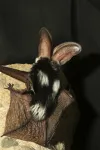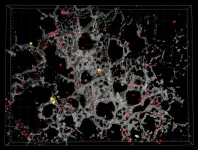(Press-News.org) BEND, Ore. - Bat researchers say a project in Central Oregon shows citizen science's strong potential for helping ecologists learn more about one of the least understood groups of mammals.
Volunteers listened for the rare spotted bat, Euderma maculatum, within study grids in a 24,000-square-kilometer area in and around the Deschutes and Ochoco national forests. They completed a total of 61 surveys and heard the bat 25 times.
Bat encounters help fill in holes in basic information regarding species abundance and distribution - gaps that impede conservation - and the proof-of-concept study's design suggests it could be scaled up to larger areas in Oregon and around the globe.
"We're really happy with the approach and think it has legs," said Tom Rodhouse, a courtesy faculty member of Oregon State University's College of Agricultural Sciences who led the project along with Sara Rose, Trent Hawkins and Rogelio Rodriguez.
Rose, Hawkins and Rodriguez work with Rodhouse in the Northwestern Bat Hub, part of OSU-Cascades' Human and Ecosystem Resiliency and Sustainability Laboratory, or HERS Lab.
Outdoor recreationists in Oregon, Washington, Nevada and Idaho are invited to help further the scientists' work by listening for spotted bats and recording encounter information through the iNaturalist app. To make sure you know what you're listening for, check out this example.
Bats navigate by echolocation, emitting pulses of sound that bounce off their surroundings and picking up the echoes with their extraordinary ears; those sonar signals are how they know where they are and what's in front of them, including prey.
Most bat sounds are above the frequency range detectible by the human ear - from 20 hertz, or cycles per second, to 20,000 hertz. However, like other bat species that eat larger insects, E. maculatum puts out sounds that people can hear: at a frequency around 10,000 hertz, and above 60 decibels, the loudness of a busy street or an alarm clock.
"Spotted bats are high-flying, hard-charging lions of the sky, trying to catch the big moths," said Rodhouse, also a National Park Service ecologist. "They're going after the big critters, calling from 20 or 40 meters away, getting a bounce and chasing it down. People with undamaged hearing can hear a spotted bat more than 60 meters away, while the range of a commercially available bat acoustic recording unit is less than 40 meters."
The scientists recruited 12 volunteers, coached them in what a spotted bat sounds like, sent them out to 100-square-kilometer grid cells and told them to stay for an hour; the volunteers visited a total of 20 cells.
Rodhouse said the study design allowed for about a 70% "detection probability" - how likely you are to detect what you're trying to detect given the methods you're using, under the assumption that it's present.
"That means on average, if the bat was there, they'd have a roughly 70% chance of hearing it," he said. "It's been a big advancement just to be able to quantify the detection probability for bats, especially the rarer ones. Non-citizen science approaches have at times been way down in the 10 to 20% range, so we're excited about increasing by three or four times the ability to find this elusive bat. We told people to go out, have a picnic, enjoy the night sounds, the coyotes, the frogs. It's a great opportunity to connect with nature."
The 25 spotted bat encounters were reported from a total of 11 cells.
"Several observers reported multiple simultaneous detections, suggesting multiple individual bats," Rodhouse said. "The audible bats tend to be the rare desert bats. They're understudied and undersurveyed, and the spotted bat is a classic example. We've been missing them for generations of research, and this is a cool nexus of the desert ecology of rare bats and a new opportunity to engage members of the public in science. And the people loved it."
Findings were published in Conservation Science and Practice.
INFORMATION:
FAYETTEVILLE, Ark. - Fine-grained location data gleaned from mobile phones shows that people living in less affluent neighborhoods spent less time at home during the early lockdown and first several months of the coronavirus pandemic.
Researchers tracked data from millions of mobile phone users in the largest U.S. metropolitan areas. Their findings contribute to a growing body of research suggesting that low-wage earners -- a vulnerable group already at greater risk for contracting COVID-19 -- could not afford to comply with stay-at-home orders or worked in ...
Global oceans absorb about 25% of the carbon dioxide released into the atmosphere when fossil fuels are burned. Electricity-eating bacteria known as photoferrotrophs could provide a boost to this essential process, according to new research from Washington University in St. Louis.
Scientists led by Arpita Bose, assistant professor of biology in Arts & Sciences, found that bacteria found in brackish sediments can "eat" electricity and, in the process, absorb and lock away climate-warming carbon dioxide. This unusual skill was previously thought to be almost exclusive to freshwater bacteria, but may be common ...
WASHINGTON--A new study finds people who consume two servings of fruit per day have 36 percent lower odds of developing type 2 diabetes than those who consume less than half a serving. The research was published in the Endocrine Society's Journal of Clinical Endocrinology & Metabolism.
Diabetes is a disease where people have too much sugar in their bloodstream, and it is a huge public health burden. Approximately 463 million adults worldwide were living with diabetes in 2019, and by 2045 this number is expected to rise to 700 million. An estimated 374 million people are at increased risk of developing type 2 diabetes, the most common form of the disease. A healthy diet and lifestyle can play a major role in lowering a person's diabetes risk.
"We ...
A new study led by researchers at Washington State University has identified a protein that could be the key to improving treatment outcomes after a heart attack.
Published in the Journal of Biological Chemistry, the research suggests that protein kinase A (PKA) plays a role in heart muscle cell necrosis, a major type of cell death that commonly occurs after reperfusion therapy, the treatment used to unblock arteries and restore blood flow after a heart attack.
"Our study has found that turning off a gene that controls this protein activity increased necrotic cell death and led to more heart injury and worse heart function following heart attack in a rodent model," said study author Zhaokang Cheng, an assistant professor in the WSU College ...
As early as the Neolithic period (circa 3900 BC), the domestication of animals likely led to the development of diseases including measles and smallpox. Since then, zoonotic disease has led to other major transnational outbreaks including HIV, Ebola, SARS, MERS, and H1N1 swine flu, among others. Currently, more than half of all existing human pathogens, and almost three-quarters of emerging infectious diseases, are zoonotic in nature.
COVID-19 is the latest and most impactful zoonotic event of the modern era, but it will certainly not be the last.
Given the breadth of these impacts and the fact that other zoonotic pandemics are highly likely - a matter of when and not if - the key public health ethics question that emerges is about whether it is ethically appropriate for governments ...
Doctors have hoped that antibiotics could benefit patients with chronic lung diseases, but a new study has found no benefit for patients with life-threatening idiopathic pulmonary fibrosis in preventing hospitalization or death.
While there were no statistical benefits for patients with the lung-scarring disease, the new research will prevent unnecessary antibiotic use that could contribute to the growing problem of antibiotic resistance. The nationwide clinical trial - believed to be the largest idiopathic pulmonary fibrosis trial ever conducted - also collected biological samples that will advance the understanding and treatment of the mysterious and ultimately fatal illness.
"We were certainly disappointed in the results. But we remain hopeful that in further downstream ...
(Carlisle, Pa.) -- A new study published in the American Journal of Lifestyle Medicine finds critical links between job loss and physical inactivity in young adults during the U.S. Great Recession of 2008-09 that can be crucial to understanding the role of adverse economic shocks on physical activity during the COVID-19 pandemic. It is the first study to examine how job losses during the Great Recession affected the physical activity of young adults in the United States.
The study by Dickinson College economist Shamma Alam and Harvard T. H. Chan School of Public Health economist Bijetri Bose looked at Panel Study of Income Dynamics (PSID) data for young adults age 18 to 27--a phase of development associated with maturation and significant ...
Professor Tetsuo Endoh's Group at Tohoku University's Center for Innovative Integrated Electronics has announced a new magnetic tunnel junction (MTJ) quad-technology that provides better endurance and reliable data retention - over 10 years - beyond the 1X nm generation.
This novel Quad technology meets the design requirements for the state-of-the-art X nm complementary metal-oxide semiconductor (CMOS) node and will pave the way for ultra-low-power consumption for Internet of Things (IoT) edge-devices in mobile communication, the automotive industry, consumer electronics, ...
Researchers from Telethon Kids Institute and Curtin University in Perth and Tulane University in New Orleans have developed sophisticated data modelling that could help eradicate malaria in Haiti.
Haiti is the poorest country in the Caribbean - beset by natural disasters - and is one of the few countries in the region that have not mostly wiped out the mosquito-borne disease.
Telethon Kids Institute researcher Associate Professor Ewan Cameron led the team, using a range of different health data to create a complete picture of where malaria infections are taking place in Haiti. This information has been used to directly inform Haiti's national response to malaria.
The team's findings ...
Treating patients with acute respiratory failure is a constant challenge in intensive care medicine. In most cases, the underlying cause is lung inflammation triggered by a bacterial infection or - more rarely, despite being frequently observed at present due to the corona pandemic - a viral infection. During the inflammation, cells of the immune system - the white blood cells - migrate to the lungs and fight the pathogens. At the same time, however, they also cause "collateral damage" in the lung tissue. If the inflammatory reaction is not resolved in time, this can result in chronic inflammation with permanent impairment of lung function. Together with colleagues from London, Madrid and Munich, a research team at the University ...







